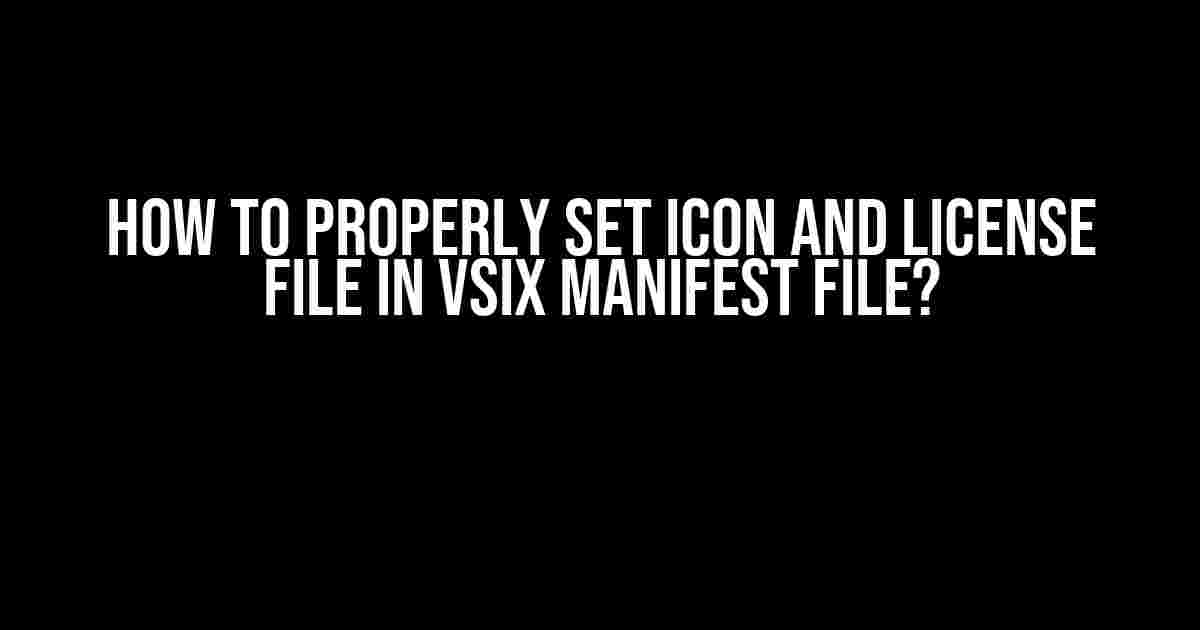Are you tired of struggling with VSIX manifest files and wondering how to properly set icons and license files? Look no further! In this comprehensive guide, we’ll take you by the hand and walk you through the process of setting icons and license files in VSIX manifest files like a pro.
What is a VSIX Manifest File?
A VSIX manifest file is a zip file that contains a visual studio extension (VSIX) package. It’s used to distribute and install Visual Studio extensions. The manifest file is an XML file that describes the extension, including its metadata, icons, and other essential information.
Why Do We Need Icons and License Files in VSIX Manifest Files?
Icons and license files are crucial components of a VSIX manifest file. Icons help users identify and distinguish your extension from others, while license files provide essential information about the terms and conditions of using your extension. Including these components in your VSIX manifest file ensures that your extension is properly represented and compliant with Visual Studio’s guidelines.
Setting Icons in VSIX Manifest File
Setting icons in VSIX manifest files involves specifying the icon’s location and type. Here’s a step-by-step guide to help you do it correctly:
-
Create an icon for your extension. The recommended size is 128×128 pixels in PNG format. You can use any image editing tool to create the icon.
-
In your VSIX manifest file, add the following code:
<Icon> <Uri>icons/your_icon.png</Uri> </Icon>Replace “icons/your_icon.png” with the actual path and name of your icon file.
-
Make sure to place the icon file in the same location as specified in the code. In this case, the icon file should be in a folder named “icons”.
-
Save and close the VSIX manifest file.
| Icon Size | Recommended Format |
|---|---|
| 128×128 pixels | PNG |
Note: You can include multiple icons of different sizes and formats in your VSIX manifest file. However, it’s essential to specify the correct path and type for each icon.
Setting License File in VSIX Manifest File
Setting a license file in VSIX manifest files involves specifying the license file’s location and content. Here’s a step-by-step guide to help you do it correctly:
-
Create a license file in plain text format (TXT) or Rich Text Format (RTF). The file should contain the terms and conditions of using your extension.
-
In your VSIX manifest file, add the following code:
<License> <Uri>license.txt</Uri> </License>Replace “license.txt” with the actual name and path of your license file.
-
Make sure to place the license file in the same location as specified in the code. In this case, the license file should be in the root directory of your VSIX package.
-
Save and close the VSIX manifest file.
| License File Format | Recommended Format |
|---|---|
| Plain Text (TXT) | Recommended |
| Rich Text Format (RTF) | Alternative |
Note: Ensure that your license file is clear, concise, and accurately represents the terms and conditions of using your extension.
Common Mistakes to Avoid
Here are some common mistakes to avoid when setting icons and license files in VSIX manifest files:
-
Forgetting to specify the correct path and type for icons and license files.
-
Failing to include the required icon and license files in the VSIX package.
-
Using incorrect file formats or sizes for icons.
-
Not providing clear and concise license terms and conditions.
Conclusion
Setting icons and license files in VSIX manifest files is a straightforward process that requires attention to detail. By following the guidelines and instructions outlined in this article, you can ensure that your Visual Studio extension is properly represented and compliant with Visual Studio’s guidelines. Remember to avoid common mistakes and test your VSIX package thoroughly before publishing it.
Now that you’ve learned how to properly set icons and license files in VSIX manifest files, go ahead and create your own Visual Studio extension! If you have any questions or need further assistance, feel free to ask.
Frequently Asked Question
Get answers to the most pressing questions about setting icons and license files in VSIX manifest files!
What is the correct file format for the icon in VSIX manifest?
A VSIX icon should be a PNG file with a minimum size of 128×128 pixels and a maximum size of 256×256 pixels. You can also use a transparent background for a more polished look!
How do I specify the icon file in the VSIX manifest?
You can specify the icon file by adding an <Icon> element to the <Identity> section of your VSIX manifest file. For example: <Icon>path/to/your/icon.png</Icon>
What type of license file should I use in my VSIX manifest?
You should use a standard license file in RTF (Rich Text Format) or HTML format. Make sure to include all necessary license terms and conditions for your extension!
How do I reference the license file in my VSIX manifest?
You can reference the license file by adding a <License> element to the <Metadata> section of your VSIX manifest file. For example: <License>path/to/your/license.rtf</License>
What happens if I don’t include an icon or license file in my VSIX manifest?
If you don’t include an icon or license file, your VSIX extension may not display correctly in the Visual Studio Marketplace or may not be approved for publishing. Make sure to include both to ensure a professional and compliant extension!

